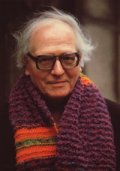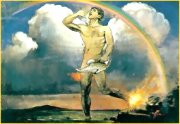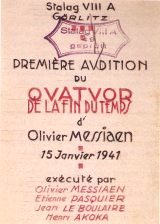
Olivier Messiaen
Olivier Messiaen is a man who is difficult to put in any convenient pigeonhole. He was firstly one of the great composers of the twentieth century. He was also a renowned organist; the bulk of his music is written for this instrument, and he held the position of chief organist at La Trinité in Paris from 1931 until his death. He was a famous teacher, his students including Boulez, Stockhausen, Nono and Xenakis.
But he was also a devout student of many subjects. He studied birds and birdsong, which he incorporated into many works, especially his
Reveil des Oiseaux,
Oiseaux Exotiques and
Catalogue d'Oiseaux. He was fascinated with ancient Greek poetry and meter. His interest also encompassed Indian ragas, Indonesian gamelan music and medieval songs.
But above all, the most important influence on Messiaen's music was his devout Catholicism. Now don't be scared off - we are not about to be bombarded with lectures and sermons. Although much of his subject matter is religious, even pious, for most of us it is a non-specific but powerful spirituality that comes across in his works.
Undoubtedly his most famous work is his
Quator pour la fin du temps or the
Quartet for the End of Time, described as the most significant piece of music to come out of the Second World War. It was inspired by the following passage from the Revelation of St. John:

And I saw another mighty angel come down from heaven, clothed with a cloud; and a rainbow was upon his head, and his face was as if it were the sun, and his feet were pillars of fire... and he set his right foot upon the sea, and his left foot on the earth... And lifted his hand to heaven. And sware by him who liveth for ever and ever saying there should be time no longer.
The circumstances under which it was written and its unusual name have certainly contributed to its fame. In fact, a bit like James Joyce's
Ulysses people refer to the
Quartet for the End of Time with respect and reverence, without in many cases having heard it.
In 1940, Olivier Messiaen was a conscript in the French army. With the fall of France, he was captured by the Germans and sent to a prisoner-of-war camp, Stalag 8A in Görlitz, Silesia. There, the extreme physical and psychological hardship inspired him to write a piece of music to be performed by fellow prisoners and performed for the camp. The scoring for the unlikely combination of piano, violin cello and clarinet is a result of the available instruments and performers in Stalag 8A>

Poster for the first performance
of Messiaen's
Quartet
for the End of Time
Messiaen later wrote “
The cold was excruciating, the Stalag was buried under snow. The four performers played on broken-down instruments. Etienne Pasquier's cello had only three strings (a claim later denied by Pasquier)
the keys on the piano went down but did not come up again. But never have I had an audience who liustened with such rapt attention and comprehension.”.
After the performance the four performers were sent back to France by their captors. “
As musicians you had no guns” said a German officer.
“
... Apocalypse contains not only monsters and cataclysms, but also moments of silent adoration and marvelous visions of peace.” said Messiaen about his work.
The
Quartet for the End of Time is made up of eight movements, eight because there a six days of creation, the seventh being the Sabbath and eight represents eternity. It showcases many of Messiaen's techniques including the first ever use of birdsong by him. It also highlights Messiaen's gift of synaesthesia or his ability to hear in colors.
1. Liturgie de cristal
“Liturgy of Crystal”
(All four instruments)
A movement of serenity, the clarinet sings a birdsong solo over an repetitive environment based on Hindu rhythms.
2. Vocalise pour l'ange qui annonce la fin du temps
“Vocalise for the angel who announces the end of time”
(All four instruments)
Sandwiched between two outer biting sections is an inner movement of calm and harmony. The Gregorian strings ride on the “distant carillon of the piano. They are the impalpable harmonies of heaven.”
3. Abîme des oiseaux
“Abyss of the Birds”
(Clarinet solo)
A test for the clarinetist, the third movement is in three sections, contrasting the Abyss of “
time with its sadness, its lassitude” and the birds in the middle movement that symbolise ou “
yearning for light, stars jubilant vocalises”.
4. Intermède
“Interlude”
(All four instruments)
A sharp contrast to the ethereal preceding movements.
5. Louange à l'éternite de Jésus
“Praise to the Eternity of Jesus”
(Duet for cello and piano)
Marked “
Infinitely slowly” a contemplative melody develops depicting the Word of Jesus.
6. Danse de la fureur pour les sept trompettes
“Dance of Fury for the Seven Trumpets”
(All four instruments)
Messiaen descibes this as a study in rhythm. All instruments play together, the Gregorian chant again. The simple repetitive melody, each a rebirth, is created from rhythm alone. This is a depiction of the apocolypse itself.
7. Fouillis d'Arcs-en-ciel pour l'ange qui annonce la fin du temps
“The tangle of rainbows for the angel who announces the end of time”
(All four instruments)
In this movement, the instruments play together bringing forth an almost orchestral sound, beginning as a series of restrained exchanges,and culminating in a “
whirl of sound and colors”.
8. Louange à l'immortalité
“Praise to the immortality of Jesus”
(Duet for violin and piano)
A second extolling of Jesus, this time his human form, this movement is a counterpart to the fifth movement. It is a return to inner meditation. The two instruments move together in a progressive ascension towards immobility and the abolition of time.
This is not easy music. It takes several listenings to come to terms with. It is possible that for some people Messiaen's
Quartet will never “click”. Messiaen's music seems at first very abstract, yet underneath the often difficult surface there are many personal elements, more spiritual than emotional.
This is music that demands the rapt attention it was given in its first performance. It may or may not work for you as a whole, but there are undoubtedly beautiful sections within it even so. And this all-star performance has become a classic.
Please support Good-Music-Guide.com
by purchasing this CD using this link.
